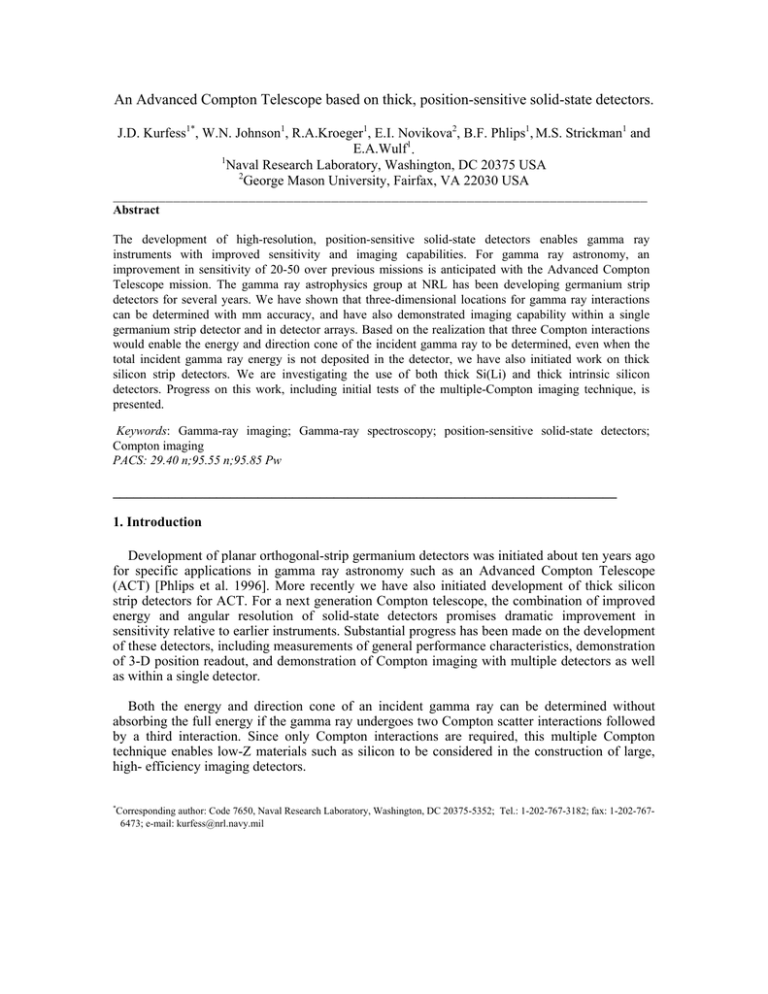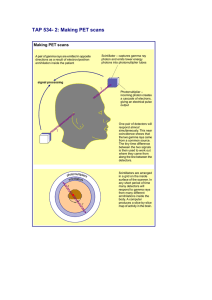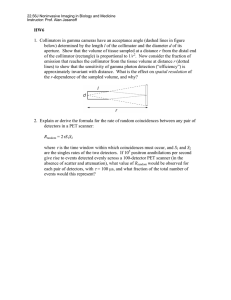An Advanced Compton Telescope based on thick, position
advertisement

An Advanced Compton Telescope based on thick, position-sensitive solid-state detectors. J.D. Kurfess1*, W.N. Johnson1, R.A.Kroeger1, E.I. Novikova2, B.F. Phlips1, M.S. Strickman1 and E.A.Wulf1. 1 Naval Research Laboratory, Washington, DC 20375 USA 2 George Mason University, Fairfax, VA 22030 USA _______________________________________________________________________ Abstract The development of high-resolution, position-sensitive solid-state detectors enables gamma ray instruments with improved sensitivity and imaging capabilities. For gamma ray astronomy, an improvement in sensitivity of 20-50 over previous missions is anticipated with the Advanced Compton Telescope mission. The gamma ray astrophysics group at NRL has been developing germanium strip detectors for several years. We have shown that three-dimensional locations for gamma ray interactions can be determined with mm accuracy, and have also demonstrated imaging capability within a single germanium strip detector and in detector arrays. Based on the realization that three Compton interactions would enable the energy and direction cone of the incident gamma ray to be determined, even when the total incident gamma ray energy is not deposited in the detector, we have also initiated work on thick silicon strip detectors. We are investigating the use of both thick Si(Li) and thick intrinsic silicon detectors. Progress on this work, including initial tests of the multiple-Compton imaging technique, is presented. Keywords: Gamma-ray imaging; Gamma-ray spectroscopy; position-sensitive solid-state detectors; Compton imaging PACS: 29.40 n;95.55 n;95.85 Pw _________________________________________________________________________ 1. Introduction Development of planar orthogonal-strip germanium detectors was initiated about ten years ago for specific applications in gamma ray astronomy such as an Advanced Compton Telescope (ACT) [Phlips et al. 1996]. More recently we have also initiated development of thick silicon strip detectors for ACT. For a next generation Compton telescope, the combination of improved energy and angular resolution of solid-state detectors promises dramatic improvement in sensitivity relative to earlier instruments. Substantial progress has been made on the development of these detectors, including measurements of general performance characteristics, demonstration of 3-D position readout, and demonstration of Compton imaging with multiple detectors as well as within a single detector. Both the energy and direction cone of an incident gamma ray can be determined without absorbing the full energy if the gamma ray undergoes two Compton scatter interactions followed by a third interaction. Since only Compton interactions are required, this multiple Compton technique enables low-Z materials such as silicon to be considered in the construction of large, high- efficiency imaging detectors. * Corresponding author: Code 7650, Naval Research Laboratory, Washington, DC 20375-5352; Tel.: 1-202-767-3182; fax: 1-202-7676473; e-mail: kurfess@nrl.navy.mil 2. Germanium Strip Detectors We have tested the performance of several germanium strip detectors that have application to an ACT. The first device that was extensively tested is a double-sided 5cm x 5cm x 1cm thick detector with a 25 x 25 array of 2 mm strips. The detector, manufactured by Canberra/Eurisys, has lithium-drifted n-type contacts and boronimplanted p-type contacts. We have used this detector to demonstrate the capability to measure the depth of gamma ray interactions to ∼0.5 mm from the relative arrival times of the electrons and holes at the opposing anodes [Wulf et al. 2002]. Figure 1 Image of a 137Cs source and a 22Na source Therefore, it is possible to determine the 3D obtained with a single germanium strip detector. locations of energy losses to less than 1mm. We have demonstrated Compton imaging with multiple detectors [Wulf et al. 2003], and have also demonstrated Compton imaging from two interactions within a single detector [Wulf et al. 2002] as shown in Figure 2. In collaboration with LBNL an orthogonal strip device using amorphous germanium as the contact technology, has been fabricated [Luke et al. 2000]. This contact technology has advantages in fabrication and is also not limited in strip pitch as are Li contacts (due to lithium diffusion). LBNL has also fabricated a larger device with amorphous germanium (amGe) contacts, 80 mm x 80 mm x 20 mm thick with 1.25 mm strip pitch. This detector is currently under test. 3. Three Compton Scatter Technique The energy and direction cone of a gamma ray can be determined, without total absorption of the energy of the gamma ray, if the incident gamma ray undergoes two Compton scatters followed by a third interaction [Kurfess et al. 2000]. Use of this technique enables large, highefficiency detectors over a broad range of energies. The energy of the incident gamma ray is given by: 1 L2 1 2 4me c 2 L2 2 + L2 + E1 = L1 + 2 2 1 − cos ϕ 2 where L1 and L2 are the energies deposited (to the recoil electrons) at the first and second interaction sites, ϕ2 is the Compton scatter angle at the second interaction site (ϕ2 is known from the locations of the first three interaction sites) and mec2 is the rest mass of the electron. The direction cone of the incoming gamma ray can be determined just as for a conventional Compton telescope. The uncertainties in the energy and direction cone of the incident gamma ray are given in Kurfess et al. [2000], and are functions of the detector’s energy and position resolutions. The standard Compton formula assumes the scattering takes place with a free electron at rest. Taking into account the pre-interaction momenta of bound electrons introduces additional uncertainties in the energy and angle of the scattered gamma ray [Ordonez et al. 1998a; Ordonez et al. 1998b]. This phenomenon is referred to as Doppler broadening. The relative uncertainties become smaller for higher energy gamma rays and for lower-Z materials [Du et al. 1999]. For 511 keV gamma rays undergoing Compton scattering in germanium, the angular uncertainty associated with the Doppler broadening is about 1 degree. The energy resolution in the triple Compton Figure 2 Energy response for a simulated 847 keV gamma ray. The higher peak represents uncertainties due to Doppler mode is degraded from that obtained with full broadening only. The lower peak peaks add uncertainies in absorption in a single detector and is also non- the energy and position resolution of the detectors. gaussian. Figure 2 shows a simulation of the expected energy distribution for 847 keV gamma rays incident on a large silicon Compton telescope. The full-width-half-maximum (FWHM) is about 10 keV, with about 50% of the events within the FWHM. It should be noted that some fraction of the events would be fully absorbed. For these, the energy resolution can be significantly better, being determined by the RMS sum of the errors at the individual energy loss locations. 4. Silicon Strip Detectors Because the three-Compton technique relies only on Compton scattering, it is possible and desirable to consider low-Z detectors for gamma ray applications. Therefore, we have initiated development of orthogonal silicon-strip detectors for these applications. Silicon should give good performance at temperatures much higher than that required for germanium. We are pursuing several alternatives for thick silicon detectors [Phlips et al. 2002]. Ideally, thick detectors with 3-D position sensitivity are desired. We have acquired several large area (57 mm x 57 mm active area, 2 mm-thick) intrinsic silicon strip detectors with 0.89 mm pitch manufactured by SINTEF Electronics and Cybernetics (Norway). One of these detectors is shown in Figure 3. In addition, several small detectors, 10mm x 30mm x 2mm thick double-sided strip detectors were also fabricated at the same time. Thicker 3-D position-sensitive devices are preferred in order to reduce the electronics channel count. This requires the use of lithiumdrifted devices. We are undertaking the development of thick, orthogonal Si(Li) strip detectors in collaboration with LBNL. Figure 4 shows a double-sided Si(Li) detector that has boron-implanted p-type contacts and amorphous silicon (amSi) n-type contacts. The detector is 3.5 mm thick and has an active area 40mm x 40mm. At –40° C, an energy resolution of about 2.2 keV is achieved on both sides of the detector [Tindall et al. 2003]. The Figure 3 SINTEF 57mm x 57mm double-sided intrinsic detector goal is to fabricate and test 50 mm x 50 mm x 6- mm thick orthogonal strip detectors (2 mm pitch) in the next several months. Following this, detectors 80mm x 80mm x 6mm thick are planned. LBNL has successfully drifted 3mm and 5mmthick wafers with an area 89mm x 89mm. Protic et al. [2002] have developed an alternate approach to fabricating thick Si(Li) strip detectors using plasma etch technology to fabricate narrow gaps in both boron-implanted and diffused-Li contacts. They have fabricated several devices that we will use to measure their performance characteristics vs. temperature. Initial results show 2-3 keV energy resolution at – 40 °C for 60 keV gamma rays from 241Am. Figure 4 Photo of double-sided Si(Li) strip detector fabricated at LBNL. The boron-contact side is seen in the mirror. Several 6-mm thick Si(Li) planar detectors were tested for radiation damage effects using a 200 MeV proton beam at the Indiana University Cyclotron Facility [Hull et al. 2003]. No degradation of the energy resolution was observed for a proton flux of 8.7 x 108 protons/cm2, which is typical of the total dose expected in a several year mission at low altitude. Very modest radiation damage effects were observed with a dose of 8.7 x 109 protons/cm2, but this damage was annealed at 60 °C. Therefore, Si(Li) detectors appear to be quite resistant to damage from the radiation environment expected for gamma ray astronomy experiments. 5. Compton Imaging with silicon detectors Figure 5 shows a 3-layer detector stack using the small detectors (approx. 5mm x 27mm x 2mm active volume) SINTEF detectors described above. We have tested this system in a triple Figure 6 Image of a 662 keV source using 3-layer intrinsic detector stack. Contours are from a simulated image using the same geometry and source. Figure 5 Three layer intrinsic silicon detector stack Compton imaging configuration using 662 keV gamma rays from a 137Cs source. Figure 6 shows the resulting reconstructed image of the source. The image was created using simple summing of the “rings” produced by each event, but no other image enhancement or cleaning. The contours are the image of simulated data (using a GEANT4 simulation code) from the same configuration and using the same analysis. Agreement between the two is quite good. Much of the background in the actual image is due to room background that was not simulated. Although the width of the source image is ~1cm, much of this width is attributable to the size of the source and the small separation between detector planes. We are currently preparing to repeat this demonstration with the larger SINTEF intrinsic Si detectors. 6. Thermal Mechanical Design A study was performed by Hytec Inc. [2002] to investigate the feasibility of making a structure that met the mechanical and thermal requirements for a large scale instrument comparable to that planned for ACT. One of the requirements imposed is that the passive material (structure, electronics) within the active envelope of the solid-state detector array be less than ∼10% of the active detector mass. This requirement is imposed to minimize the loss of those events, particularly in the multiple Compton mode, where gamma rays interact in passive material before two or three interactions occur in the detector, and therefore prevent proper Compton kinematic reconstruction of the energy and direction of the incident gamma ray. The study concluded that a structure could be built out of aluminum and provide thermal/structural support for all the detectors, yet only contribute ∼10% of the total mass inside the “active envelope” of the detector. In this design, self-supporting silicon detectors arrays are fabricated by edge bonding the silicon detectors into 3x3 or 4x4 arrays. The silicon detectors are daisychained to read-out the top and bottom strips from two sides of each array. This design Figure 7 Exaggerated mechanical deformation expected for relies on a concept where the columns holding an ACT in typical launch environments. the various detector layers also serve as the cooling pipes. It also relies on individual layers being connected to the cooling pipes using clamping rings made of shape memory alloys. These metallic rings shrink when heated. To prove the feasibility of this concept, test pieces were manufactured that simulated the interface between a layer and the cooling pipe. Tests show that the shape memory alloy rings are able to hold a layer over the required range of temperatures and through the vibration levels typical of expected launch environment. A computer model of this design (Figure 7) has been developed and used for vibration studies to verify that the design would be compatible with the expected launch environment expected for ACT. 7. Plans In the immediate future, we plan to build a small, three-layer Compton telescope using 2x2 arrays of 63mm x 63mm x 2mm-thick SINTEF detectors and test various performance parameters including energy and angular resolution in the multiple Compton mode of operations, and polarization sensitivity. We also plan to test both larger area and thicker Si(Li) detectors and intrinsic detectors. Following these tests, we plan to make a larger scale version of a silicon Compton telescope for functional and environmental testing, as shown in Figure 8. This instrument will also be suitable for a balloon-borne test flight. Figure 8 Exploded view of a mechanical design for a prototype multi-layer silicon Compton telescope. 8. Acknowledgements This work was supported by the Office of Naval Research, the National Aeronautics and Space Administration, and the Defense Threat Reduction Agency. References Du, Y.F., Z. He, G.F. Knoll, D.K. Wehe, and W. Li "Evaluation of a Compton scattering camera using 3-D position sensitive CdZnTe detectors", Proc. SPIE, vol. 3768, pp.228-238, 1999. Hull, E. L., et al. Richard H. Pehl, Craig Tindall, Paul N. Luke, James D. Kurfess, ”Radiation damage and charge collection in Si(Li) gamma-ray detectors”, Nucl. Instr. & Meth. 496, 123-128, 2003 Hytec, Inc. 110 Eastgate Dr., Suite 100, Los Alamos, NM 87544 Luke, P.N., M. Amman, B.F. Phlips, W.N. Johnson, R.A. Kroeger, “Germanium orthogonal strip detectors with amorphous-semiconductor contacts”, IEEE Trans Nucl Sci. vol. 47, pp. 1360 –1363, 2000. Kurfess, J.D., W.N. Johnson, R.A. Kroeger, and B.F. Phlips, "Considerations for the Next Compton Telescope Mission " AIP Conf. Proc. vol. 510, pp. 789-793, 2000. Ordonez, C.E., A. Bolozdynya, and W. Chang, "Doppler broadening of energy spectra in Compton cameras", 1997 IEEE Nucl Sci. Symp. vol. 2, pp. 1361-1365, 1998. Ordonez ,C.E., A. Bolozdynya, and W. Chang "Dependence of Angular Uncertainties on the Energy Resolution of Compton Cameras", IEEE Nucl. Sci. Symp. , vol. 2, pp. 1122-1125, 1998. Phlips, B.F., S. E. Inderhees, R. A. Kroeger, W. N. Johnson, R. L. Kinzer, J. D. Kurfess, B. L. Graham,and N. Gehrels, ” Performance of a compton telescope using position-sensitive germanium detectors”, IEEE Trans Nucl Sci. 43 (3): 1472-1475 Part 2, 1996. Phlips, B .F., et al. “Development of Thick Intrinsic Silicon Detectors for Hard X-ray and Gamma–ray Detection” 2001 IEEE Nuclear Sciences Symposium Conf. Record, paper N12-12, 2002. Protic, D., T. Krings, and R. Schleichert “Development of Double-sided Microstructured Si(Li)-Detectors 2001 IEEE Nuclear Sciences Symposium Conf. Record, paper R16-2, 2002. Tindall, C., et al., “Evaluation of Si(Li) detectors for use in Compton Telescopes” Nucl. Instr. Meth. in Phys. Res. A 505 130-135, 2003. Wulf, E. A., J. Ampe, W. N. Johnson. R. A. Kroeger, J. D. Kurfess,and B. F. Phlips,, “Depth Measurement in a Germanium Strip Detector” Trans. Nucl. Sci. 49 1876-1880, 2002. Wulf, E. A., J. Ampe, W. N. Johnson, R. A. Kroeger, J. D. Kurfess and B. F. Phlips, “Depth Measurement in a Strip Detector”, 2001 IEEE Nuclear Sciences Symposium Conf. Record, 2002.

